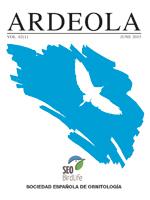We studied the phenology, habitat selection, and interannual and seasonal changes in breeding performance of the little grebe Tachybaptus ruficollis in relation to the spatial structure of a shallow lake during three breeding seasons (2010–2012). Nests were mostly located in shallow waters, close to the shore (98.3 ± 37.9 cm), in vegetation dominated by Scirpus lacustris. The egg-laying period started at the end of March and extended for four months until the end of July. Overall, the mean clutch size was 4.7 ± 1.1 (N = 154) with a modal clutch of 5. There was a seasonal decline in both egg volume and clutch size. The overall nesting success was 60% and the chief causes of nest failure were predation (52%) and adverse weather (20%). Breeding outcome was influenced by water depth, nest size and year of breeding. Predation and nest flooding markedly varied between years. Larger nests had a higher nesting success than smaller ones. Likewise, nests located at greater water depth (further from the shore) succeeded better than ones located in shallower water. As the little grebe forages preferentially in shallow waters, these results suggest that optimal nesting locations may be the result of a trade-off between conflicting selection pressures such as foraging efficiency (better in shallow waters) and nest predation risk (greater in shallow waters).
How to translate text using browser tools
1 June 2015
Nest-Site Selection and Reproductive Success of the Little Grebe Tachybaptus ruficollis in Northeast Algeria
Mohammed Athamnia,
Farrah Samraoui,
Bilal Kelailia,
Ahlem Rouabah,
Ahmed H. Alfarhan,
Boudjéma Samraoui
ACCESS THE FULL ARTICLE

Ardeola
Vol. 62 • No. 1
June 2015
Vol. 62 • No. 1
June 2015
aves acuáticas
breeding ecology
clutch size
ecología de la reproducción
éxito de nidificación
humedales
lago Tonga




